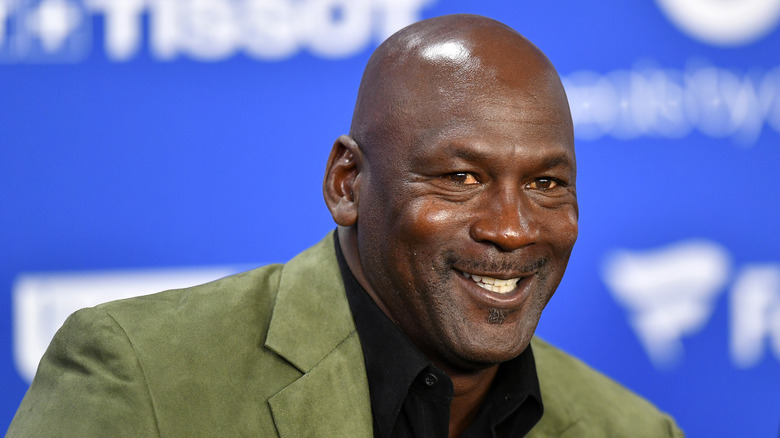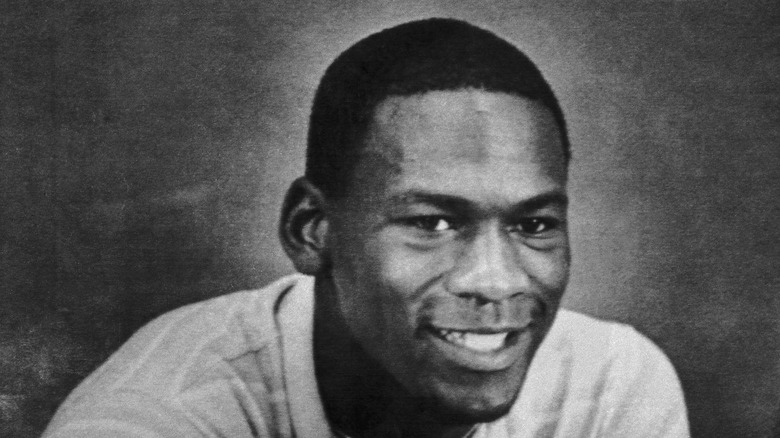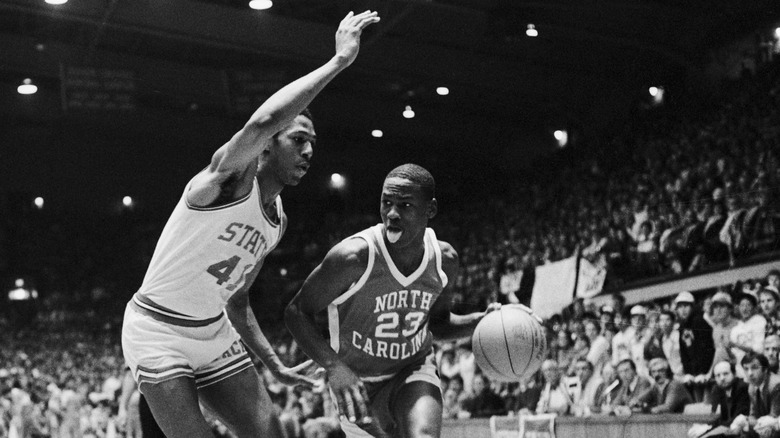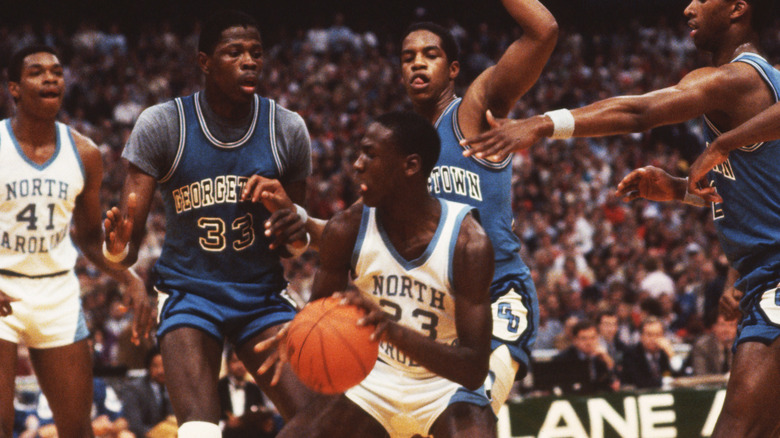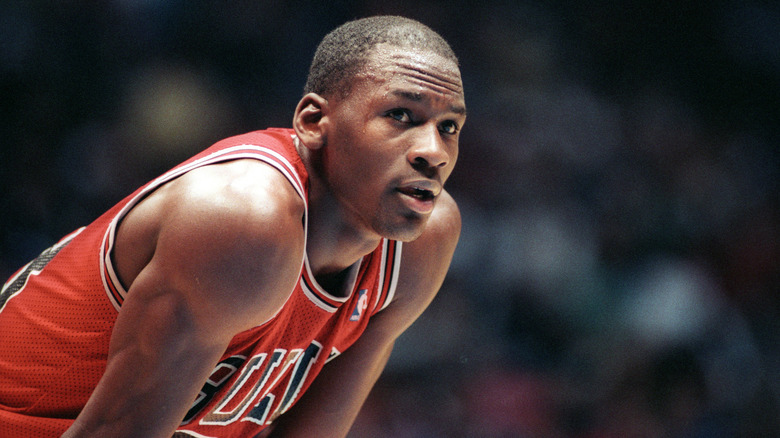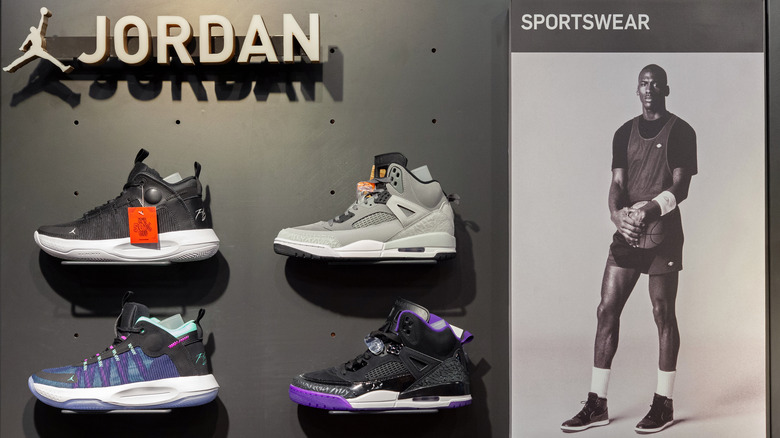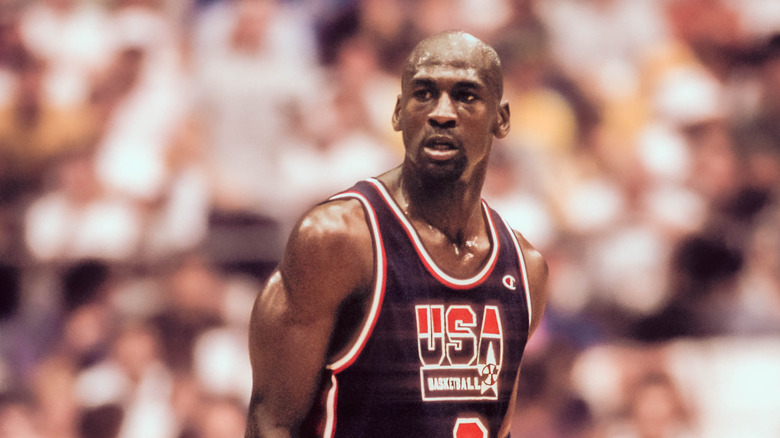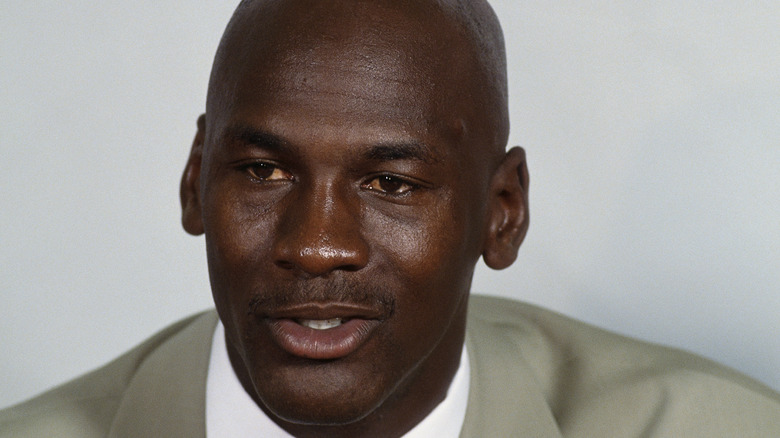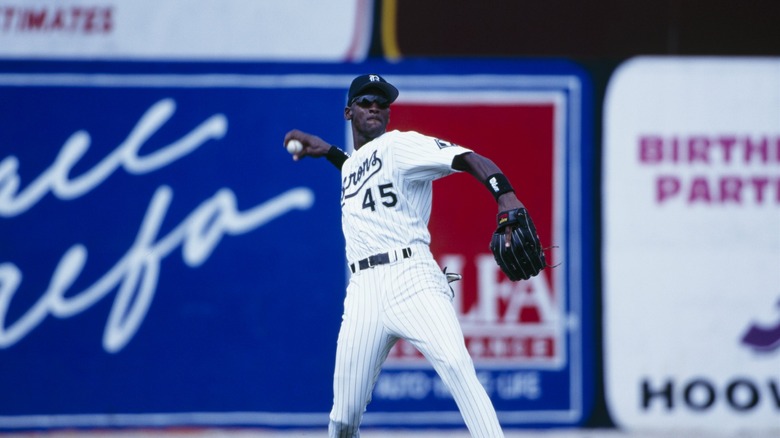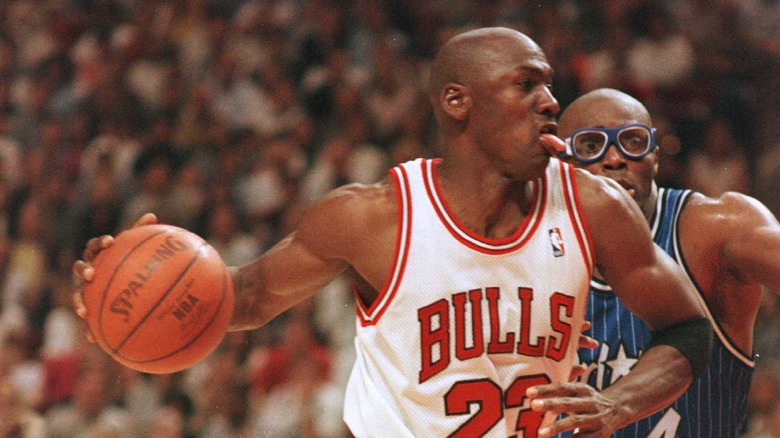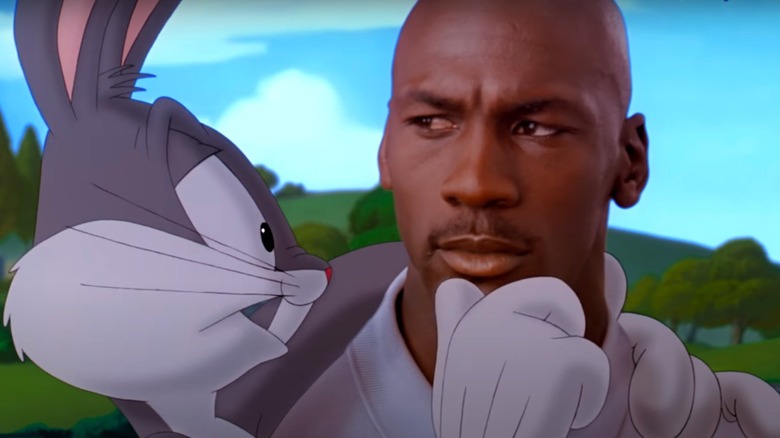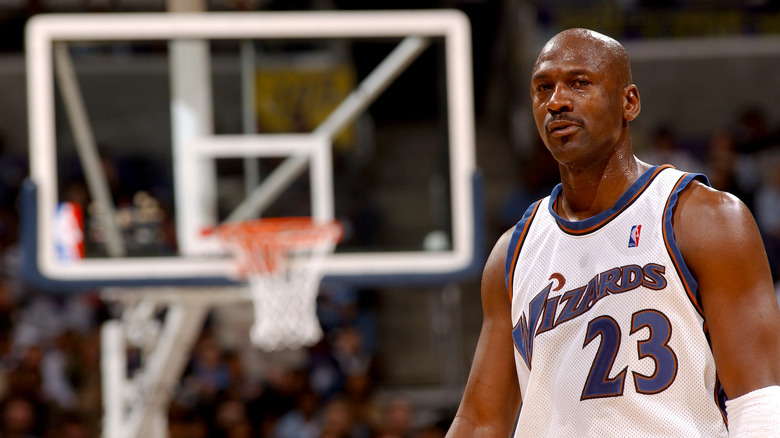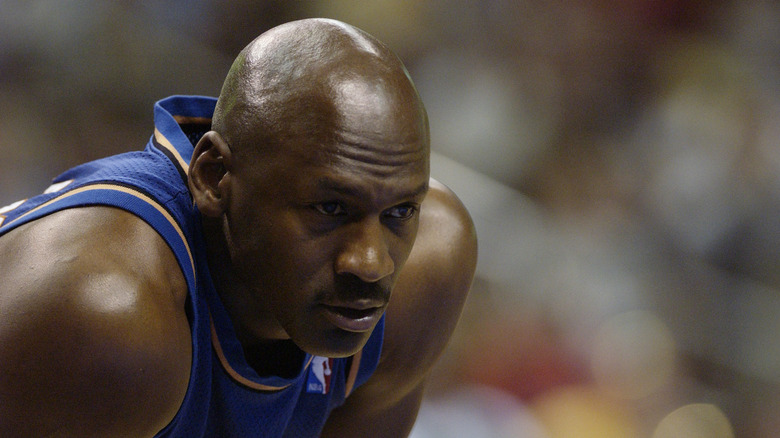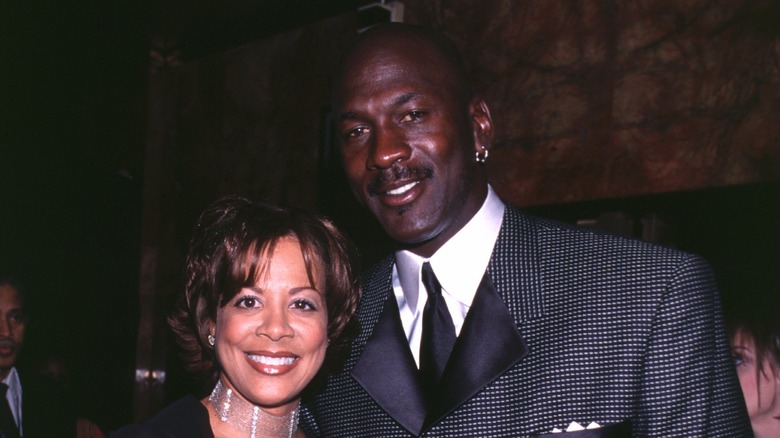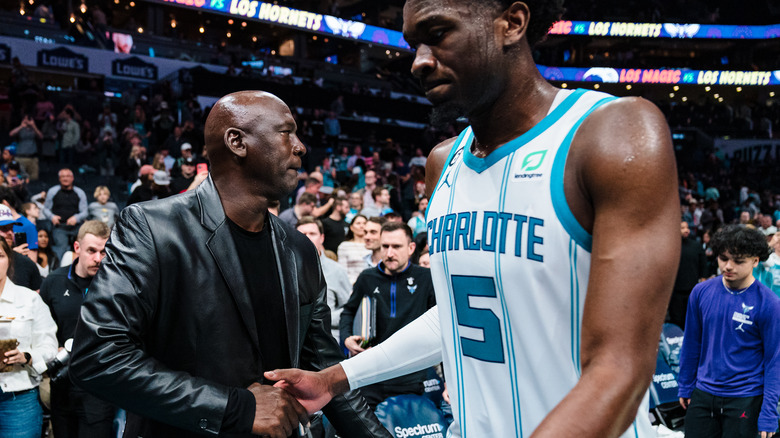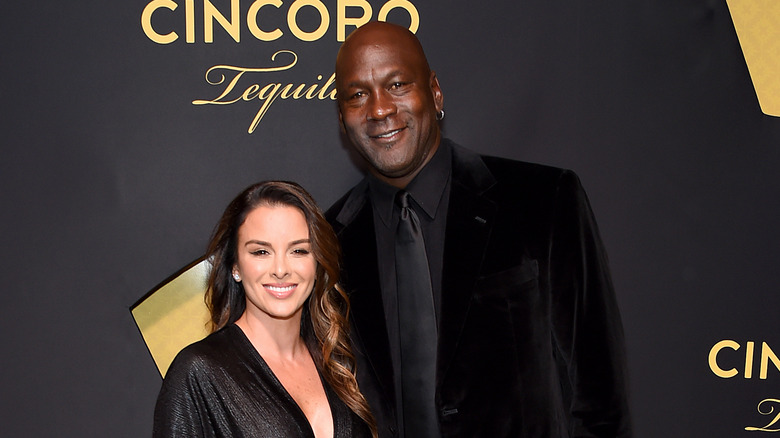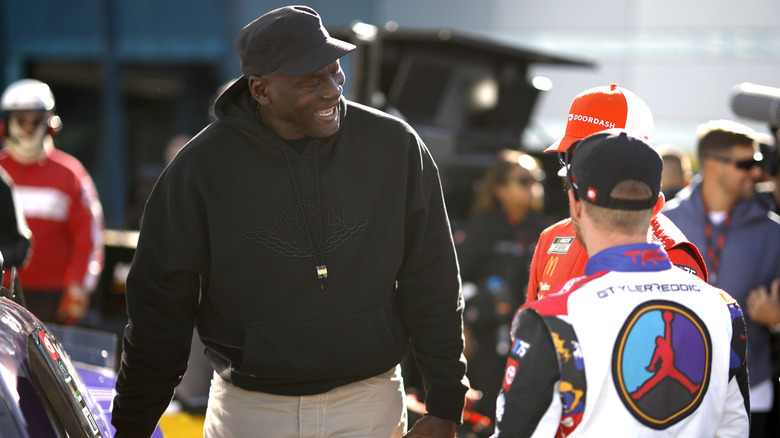The Stunning Transformation Of Michael Jordan
Was there ever a better basketball player than Michael Jordan? Not according to the NBA, which unequivocally declared, "By acclamation, Michael Jordan is the greatest basketball player of all time." That's backed up by Jordan's achievements during his 15-season stint in the NBA. During his years with the Chicago Bulls, he led the team to six NBA championships and was deemed the league's most valuable player five times. In 1999, he was honored by ESPN as the greatest North American athlete of the 20th century, topping such fellow sports legends as Babe Ruth, Muhammad Ali, and Jim Brown.
Then, of course, there are his achievements on the court during the 1992 Summer Olympics in Barcelona, where he and the rest of the U.S. men's Olympic basketball team — dubbed the "Dream Team" by the media — won a gold medal (Jordan's second). Jordan and Bulls teammate Scottie Pippen made history that year as the first players ever to win both an Olympic gold medal and an NBA championship within the same year.
Yet Jordan's prowess at basketball is just one facet of his fascinating life, which has also included his practically ubiquitous Air Jordan line of sneakers for Nike, becoming a sports team owner, achieving movie stardom, and much more. Not just one of the world's most renowned athletes, he's also one of the planet's most famous humans; to find out how he got there, read on to experience the stunning transformation of Michael Jordan.
Michael Jordan demonstrated athletic talent from a young age
Michael Jordan was born in Brooklyn on February 17, 1963, but grew up in Wilmington, North Carolina. From an early age, he displayed exceptional athletic ability, playing whatever sport was in season and excelling. That included Pop Warner football, but his real love was baseball. He was just 12, in fact, when he was named MVP while competing in a state baseball tournament.
Jordan eventually gravitated to basketball. In 1978, the 15-year-old, standing just five-foot-10 and still not able to dunk the ball, tried out for his school's varsity team but wasn't chosen. The discouragement he felt evolved into a steely resolve to make it next time. "Whenever I was working out and got tired and figured I ought to stop, I'd close my eyes and see that list in the locker room without my name on it," Jordan told Newsweek.
By the following year, Jordan was both bigger and better, having built muscle mass while gaining four inches of height. This time he made the team, and during the course of the season, his abilities exploded. "His level of play was just so much higher than the rest of us," Jordan's older brother, Larry, told ESPN, recalling watching his little brother eclipse him on the court. "People ask me all the time if it bothered me, but I can honestly say no, because I had the opportunity to see him grow," he explained. "I knew how hard he worked."
He became a standout in college hoops
After being named a McDonald's All American in high school, in 1981 Michael Jordan earned a basketball scholarship to attend the University of North Carolina at Chapel Hill. It didn't take long for him to make an impact as a member of the North Carolina Tar Heels; during his first game, Jordan scored an impressive 12 points.
While Jordan's potential was obvious, during his freshman year he also proved at times to be inconsistent. Under the tutelage of the team's coach, Dean Smith, Jordan began honing his skills. As the season progressed, so did Jordan's scoring, as Smith worked with Jordan to improve his ball-handling and passing. All that work paid dividends; when he entered his sophomore year, not only had his height increased to six-foot-six, but so too had his level of skills on the court increased. By his junior year, Jordan's future as an NBA prospect was seen by his coach as an inevitability.
While Jordan clearly worked hard on his athletic ability during his years at UNC, that may not have been the case with the academic side of his college education. In 2014, Jordan's academic record wound up in the hands of an auction house. The document revealed that Jordan majored in geography, with his freshman course load including such classes as beginning tennis, basic writing, and elementary Portuguese.
The single shot that changed everything
Michael Jordan may have shown inconsistencies in his freshman-year gameplay, but one game that season ultimately proved just how unmatched he is on the court. After leading the team to the 1982 NCAA championship game, the Tar Heels faced stiff competition from the Georgetown Hoyas, led by star player Patrick Ewing. While Jordan played hard, he wasn't his team's highest scorer in that game; teammate James Worthy, who went on to NBA glory with the Los Angeles Lakers, led the scoring for that game, with 28 points. As the clock ticked down toward the end of the second half, Georgetown had a narrow 62-61 lead when Jordan gained control of the ball. With just 17 seconds remaining, Jordan took an audacious shot and sunk it, winning the game in what came to become a defining moment for him.
More than three decades later, Jordan attended the 2016 NCAA championships to watch his alma mater compete. Interviewed on TBS (via Vice), Jordan recalled how that single shot ended up changing everything for him. "You know, that's the birth of Michael Jordan," he said. "Before then, I was 'Mike' Jordan. All of a sudden I make that shot, I'm 'Michael' Jordan ... for me, it started [my] career."
In 1984, Jordan was selected for the U.S. men's basketball team, leading the team to a gold medal at the Summer Olympic Games in Los Angeles and winning all their games in an impressive 8-0 sweep.
He quickly became the Chicago Bulls MVP
Following his stellar performance at the Olympics, Jordan was the third player picked in the 1984 NBA draft, going to the Chicago Bulls. As WTTW recalled, Bernard King, who'd played alongside Jordan at the Olympics in L.A., famously declared, "All I can say is that the people in Chicago are in for a real treat." With all that hype preceding him, it's fair to say expectations for the Bulls' new acquisition were sky-high. "'He's got to produce immediately. It can't be down the road. The question is: Can this player do it?” Bulls coach Kevin Loughery told The New York Times.
Jordan could and he did, dazzling fans during his rookie season, soaring through the air to deliver dynamic dunks while demonstrating a mastery of the layup. A big obstacle reared its head during Jordan's second season in the league when he suffered an injury, breaking a bone in his foot. He overcame that injury and went on to lead the Bulls to three consecutive NBA championships, in 1991, 1992, and 1993.
Speaking during a 1993 press conference, immediately after the Bulls' legendary "three-peat," Jordan pointed out the importance of that achievement given the unprecedented degree of talent within the NBA. "We feel we must be considered one of the best teams ever," he said. "To say that we won three in a row, and I was part of the team, that means a lot."
His partnership with Nike has netted him more than a billion dollars
Shortly after being drafted by the Chicago Bulls in 1984, rookie Michael Jordan took a meeting with Nike's Sonny Vaccaro about an endorsement deal with the brand. While Jordan was tempted to sign with a more established shoe brand — Adidas or Converse were heavily courting him — the offer from Nike was a lucrative one: $2.5 million over five years, more than double what the other brands had offered. That partnership resulted in the first shoe that would establish the Air Jordan line, the Jordan 1. Initially sold in just six states, the company expected to sell 100,000 pairs in the first year and build from there. Those expectations, however, were shattered when a staggering 450,000 pairs were sold in the first month of release.
Interestingly, Jordan can thank the business savvy of his mother, Deloris Jordan, for how lucrative that deal came to be for him. As The Mirror recalled, Jordan's mother was the one who pushed him to consider Nike after his initial disinterest in the brand, and it was she who helped negotiate the terms for him. Before agreeing to the deal, she demanded one crucial addition: that Nike give her son a 5% royalty on all shoes bearing his name and likeness. Nike agreed.
The Air Jordan brand went on to become wildly successful. According to Inc., Jordan has earned a staggering $1.5 billion from his Nike partnership thanks to that 5%.
Olympic glory with the Dream Team
Michael Jordan was a season away from his "three-peat" with the Bulls when he was once again tapped for play for the U.S. men's basketball team at the 1992 Summer Olympics. That particular year marked a big rule change that allowed professional basketball players in the mix for the first time ever. The resulting team was dubbed the Dream Team, in which Jordan was joined by a stunning array of talent, including Scottie Pippen, Larry Bird, Magic Johnson, Patrick Ewing, Charles Barkley, and more.
"I look to my right, there's Michael Jordan ... I look to my left, there's Charles Barkley or Larry Bird," Johnson later recalled, via the official Olympics website. "I didn't know who to throw the ball to!" Those who watched enjoyed some of the best basketball ever played, although it was difficult not to pity their opponents; the Dream Team defeated each opposing team by an average of 44 points and didn't lose a single one of the eight games played.
Over the years, what's become even more legendary than the team's gold medal win (after besting Croatia in a lopsided 47-point victory) is a scrimmage in which the NBA's top players pulled out all the stops attempting to top each other. "Everybody asks me about that game," Jordan told Sports Illustrated, which dubbed the scrimmage the "greatest game nobody ever saw." Added Jordan: "It was the most fun I ever had on a basketball court."
Scandal emerged when his gambling habit was exposed
After Michael Jordan and the Chicago Bulls won their third consecutive NBA championship in 1993, the basketball phenom had rightfully earned a reputation as one of the world's top athletes. In the midst of that glory, however, scandal reared its ugly head after reports emerged that he'd lost $57,000 on a golf bet to James "Slim" Bouler. Jordan claimed the check he'd written was a loan he'd given Bouler for a business opportunity.
In response, the NBA tapped former federal judge and U.S. attorney Frederick Lacey to launch an investigation into Jordan's gambling. When Bouler was subsequently charged with unrelated charges of money laundering, Jordan was called to testify, and admitted under oath that the money was no loan, but covered his gambling debt. Whispers that Jordan's gambling had become problematic recurred when he was later spotted placing bets at an Atlantic City casino.
Those whispers grew louder, reported The Washington Post, after businessman Richard Esquinas claimed that Jordan owed him a whopping $1.25 million from golf gambling. Jordan confirmed that claim's veracity, and that he and Esquinas agreed to a $300,000 settlement. There were further rumors that he'd gambled with some other athletes. This led to Lacey launching a second investigation, although there were questions about how aggressively it was being pursued. "I gambled and played golf with Michael for six summers but the NBA hasn't even called me," Bouler told the Post. "What kind of an investigation is that?"
His first retirement and a shift to baseball
After winning three straight NBA titles, the last thing anybody expected Michael Jordan to do was retire. Yet that's precisely what he did, walking away from the NBA after nine seasons with the Chicago Bulls at age 30. "It's not because I don't love the game," he explained during his news conference. "I love the game of basketball. I always will. I just feel that, at this particular time in my career, I have reached the pinnacle of my career ... I just feel that I don't have anything else for myself to prove."
That may have been true when it came to basketball, but Jordan had plenty to prove in his other favorite sport, baseball. Even though he hadn't played baseball since high school, Jordan wanted to see if he still had it. Months after announcing his basketball retirement, Jordan was signed by the Chicago White Sox and headed to Florida for spring training. Ahead of the season, he left sports reporters impressed by scoring a couple of hits during an exhibition game. "It was a great feeling just to come out and do well," Jordan told The New York Times.
Jordan's gameplay, however, was eventually deemed to be not up to MLB standards. He was began his baseball career in the minors, and assigned to the Birmingham Barons. Jordan accepted his fate pragmatically. "I've been cut before," Jordan told UPI. He wound up spending just one season with the Barons.
His triumphant return to the Bulls led to a second 'three-peat'
During his retirement press conference, Michael Jordan was asked if he'd ever return to basketball. "If I desire to come back and play again, maybe that's what I want to do," he said, reported by the Chicago Tribune. "Maybe that's the challenge that I may need someday down the road. I'm not going to close that door."
He kicked that door wide open in a brief announcement he sent via fax in March 1995. That note, reported the Chicago Tribune, consisted of just two words: "I'm back." Bulls coach Phil Jackson confirmed the news in a brief statement of his own: "Today, Michael Jordan was activated as a Chicago Bull." Despite being away from the game for more than a year and a half, Jordan hadn't lost a step. He once again led the team to the NBA playoffs. While the Bulls didn't win that season (losing in the second round of playoffs), Jordan took the team to a second "three-peat," winning the NBA championship in 1996, 1997, and again in 1998.
That 1997-'98 season, in fact, has become so legendary that it formed the focus of a 2020 Netflix docuseries, "The Last Dance," offering fans insights into the surprisingly fraught behind-the-scenes situations preceding that extraordinary win. One episode dealt with Jordan's treatment of his teammates in his quest for victory, revealing they were terrified of him. "Let's not get it wrong," ex-Bull Will Perdue said. "He was an a**hole ... He crossed the line numerous times."
A big-screen slam dunk with Space Jam
"Space Jam" hit theaters in November 1996, with Michael Jordan starring in his first movie. The film was the culmination of Jordan's near-ubiquity in the media during that era, teaming him with Bugs Bunny and the Looney Tunes gang to compete in a basketball game against a team of fearsome, marauding cartoon aliens.
Jordan shot his scenes for the film during the summer of 1995, filming during the day and playing basketball at night. Those games were held in an inflatable dome — dubbed the Jordan Dome — that had been set up in a parking lot in Warner Bros. studios, with Jordan inviting fellow NBA stars including Dennis Rodman, Patrick Ewing, Reggie Miller, and others to join him for pickup games so he could physically prepare for the upcoming season. "What stood out the most to me was how Jordan could film all day and some evenings and still come out and play two to three hours of games," Miller told Basketball Network. "Most of our pickup games began around 7 p.m. and lasted until 10. His call time on set the next morning would be around 5 or 6 a.m."
The film proved to be a hit, raking in $230 million at the worldwide box office. The real money, however, came from the massive merchandising blitz, which reportedly brought in an additional $1.2 billion. Jordan reportedly had a piece of those profits, and walked away from the film $20 million richer.
His second retirement didn't last long
After winning the 1998 NBA championship, in January 1999 Michael Jordan made a big announcement: he was retiring for a second time. "Mentally, I'm exhausted," Jordan said during a press conference, reported by The Washington Post. "I never say never," the 38-year-old added, but insisted he was "99.9 percent" certain he wouldn't return to the NBA. "You can read that for what it's worth," he declared.
The following January, Jordan announced a new gig: part owner and president of basketball operations for the Washington Wizards. "I look forward to turning this thing around," he said of the flailing NBA franchise, reported The Washington Post. "Right now we're an underachieving team."
In September 2001, Jordan announced he was coming out of retirement a second time — this time playing for the Wizards. "I am returning as a player to the game I love," said Jordan, as reported by Associated Press. "I am especially excited about the Washington Wizards, and I'm convinced we have the foundation on which to build a playoff-contention team." In 2002, Jordan's age was seemingly a factor when a knee injury, requiring surgery, left him sidelined for a chunk of the season. However, there were still flashes of the old fire, such as a 2003 game against the New Jersey Nets, in which Jordan became the first-ever 40-year-old to score 40 points in a single game (he scored 43). He did not, however, take his new team to the NBA finals.
Final retirement and a failed attempt at motorsports
On April 16, 2003, Jordan retired for a third and final time, played his final NBA game, and scored 15 points in the process. While reports at the time indicated it was Jordan who made the decision to retire, CBS News subsequently reported on the claims of an anonymous source inside the Washington Wizards that it was actually team owner Abe Pollin who cut Jordan loose. The reason was said to be "deteriorating relationships" within the franchise. Reports later emerged that Jordan was so despised by his teammates, with Washington Post sports columnist Mike Wise revealing that late Wizards GM Wes Unseld once told him that when he asked Jordan's fellow players to contribute for a retirement gift, every single one turned their backs to him.
After retiring, Jordan set his sights on a new pursuit when he founded Michael Jordan Motorsports. Jordan had long been a motorcycle aficionado, and in 2004 channeled that interest into his new venture by running his own motorsports team to compete in the AMA Pro Superbike series. Despite a roster of talented riders, Jordan's team was unable to make much of a dent in competitions, primarily because the factory-owned teams continually brought the best machines to the track.
Michael Jordan Motorsports finally logged its first win in 2010. However, financial challenges and the loss of a key sponsor combined to put an end to Jordan's motorbike ambitions, with operations suspended in late 2013.
His divorce was insanely expensive
Back in 1989, Michael Jordan married Juanita Vanoy, with the ceremony taking place in a Las Vegas wedding chapel. That marriage lasted for 17 years until the couple split up in 2006. "Michael and Juanita Jordan mutually and amicably decided to end their 17-year marriage," the couple's lawyers said in a statement to People. "A judgment for dissolution of their marriage was entered today. There will be no further statements." As the outlet pointed out, Juanita had previously filed for divorce in 2002, amid rumors of Jordan's continual infidelity. However, the couple were able to work out their issues and reconcile.
That wasn't the case with the second filing. At the time, Forbes speculated that Jordan could be forced to pay his ex-wife a settlement of more than $150 million, which would make the Jordans' divorce the most costly in the history of entertainment. When the dust settled, that settlement was even higher than estimated, with Jordan paying $168 million.
And while that was indeed the most expensive celebrity divorce at the time, a few years later the Jordans' divorce was eclipsed by the dissolution of Mel Gibson's marriage to wife Robyn — which was estimated to have cost the "Lethal Weapon" star $425 million.
He bought and sold the Charlotte Hornets
In 2006, Michael Jordan began investing in the Charlotte Bobcats. In 2010, Jordan made a $275 million bid to gain controlling interest in the team, fulfilling his dream of becoming a majority owner of an NBA franchise. In 2014, Jordan had increased his ownership stake, holding 89.5% of the team; according to Forbes, at that point, the team was estimated to be worth somewhere between $600 million and $625 million. Jordan was also instrumental in rebranding the team under an exciting moniker. The Charlotte Bobcats began as an expansion team that came to Charlotte after the Hornets moved to New Orleans; when the New Orleans Hornets changed their name to the Pelicans, the Charlotte Bobcats then reclaimed the Hornets name in 2014, officially becoming the Charlotte Hornets.
In 2023, after a 13-year run as the team's owner, Jordan decided to sell his stake in the team. The buyer was a group headed by Gabe Plotkin, who already owned a minority stake in the team, and Rick Schnall, who owned a minority share of the Atlanta Hawks. The sale price was a staggering $3 billion, approved in a near-unanimous vote by NBA team owners.
"The opportunity to be the majority owner of the Charlotte Hornets in my home state of North Carolina for the last 13 years has been a tremendous honor," said Jordan in a statement, as reported by CBS News. "I'm proud of all that the organization accomplished: the exciting on-court moments, the return of the Hornets name, Charlotte hosting the 2019 NBA All-Star Game and HSE becoming a true pillar of this community."
He got remarried and started a new family
In April 2013, Jordan tied the knot with Yvette Prieto, after getting engaged back in 2011. As Us Weekly reported, the two exchanged vows in a lavish ceremony in Palm Beach. The wedding — which reportedly cost $10 million — boasted a star-studded guest list that included Tiger Woods, Scottie Pippen, Patrick Ewing, Spike Lee, Robin Thicke, Usher, and other celebs.
There's no question that Michael Jordan's considerable fortune took a hit after his divorce, and he reportedly entered his second marriage with an ironclad prenup in place. According to the National Enquirer, if the two were to divorce, Prieto would be paid $1 million for each year of their marriage; after 10 years of marriage, that amount would then increase to $5 million per year. "Michael loves Yvette, but he won't let that interfere with his common sense — and his money — like it did before," a source told the Enquirer, as detailed by the Daily Mail, which noted that Preito took no issue with the prenup. "She can't imagine that they'd ever split up!" the source shared.
The couple wasted little time in starting a family; the following February, just 10 months after their wedding, they welcomed twin daughters, Victoria and Ysabel. "Yvette Jordan and the babies are doing well and the family is overjoyed at their arrival," a spokesperson said in a statement to CBS News.
He formed a NASCAR team
In 2020, Michael Jordan cast his eye on a new challenge when he partnered with Denny Hamlin — a three-time Daytona 500 winner — to launch their own NASCAR Cup Series race team. The first driver they signed was Bubba Wallace, the sole Black driver in the NASCAR Cup Series. Hamlin and Jordan subsequently revealed the team's name, 23XI Racing, a combination of Jordan's number with the Chicago Bulls (23), and the car number that Hamlin drove during his racing career (11). "At the end of the day, they are the ones ultimately in control because they're the ones signing them checks," Wallace joked of his new bosses during an interview with Fox NASCAR, via NASCAR. Jordan emphasized his faith in Wallace when he quipped, "The thing is, we don't sign checks to losers."
23XI Racing got off to a soaring start when Wallace won the 2021 fall race at the famed Talladega Superspeedway — the first time a Black driver had ever won that particular race, and the first-ever win for the fledgling team.
The team next signed NASCAR veteran Kurt Busch, who brought 23XI its second win when he crossed the finish line in the AdventHealth 400 race in Kansas, driving an Air Jordan-inspired car. The following season, in October 2022, Wallace brought the team another win when he emerged victorious at Kansas Speedway. In 2022, 23XI announced that Tyler Reddick was joining the team; he eventually replaced Busch when he retired in 2023.

